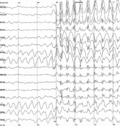Spike-and-wave
Spike-and-wave is a pattern of the electroencephalogram (EEG) typically observed in generalized epilepsy. The pattern is characterized by a high voltage spike followed by a slow wave. The spike represents the electrical discharge of neurons, while the wave is the result of a compensatory polarization process. The spike-and-wave pattern is typically seen in generalized seizures, but can also be seen in focal seizures.
Overview[edit]
The spike-and-wave pattern is a characteristic feature of certain types of seizures, particularly those classified as generalized seizures. These seizures involve both sides of the brain simultaneously, and are often associated with a loss of consciousness. The spike-and-wave pattern is thought to reflect the underlying neuronal activity during these seizures.
Mechanism[edit]
The spike-and-wave pattern is thought to result from a complex interaction between neurons and the inhibitory cells that regulate them. The "spike" represents a sudden burst of electrical activity, while the "wave" represents a subsequent period of reduced activity or inhibition. This pattern is thought to reflect the balance between excitation and inhibition in the brain.
Clinical significance[edit]
The presence of a spike-and-wave pattern on an EEG is often used to confirm a diagnosis of epilepsy. However, it is not specific to epilepsy, and can be seen in other conditions as well. The pattern can also be seen in individuals without epilepsy, particularly during sleep.
See also[edit]
References[edit]
<references />
Ad. Transform your life with W8MD's Budget GLP-1 injections from $75


W8MD offers a medical weight loss program to lose weight in Philadelphia. Our physician-supervised medical weight loss provides:
- Weight loss injections in NYC (generic and brand names):
- Zepbound / Mounjaro, Wegovy / Ozempic, Saxenda
- Most insurances accepted or discounted self-pay rates. We will obtain insurance prior authorizations if needed.
- Generic GLP1 weight loss injections from $75 for the starting dose.
- Also offer prescription weight loss medications including Phentermine, Qsymia, Diethylpropion, Contrave etc.
NYC weight loss doctor appointmentsNYC weight loss doctor appointments
Start your NYC weight loss journey today at our NYC medical weight loss and Philadelphia medical weight loss clinics.
- Call 718-946-5500 to lose weight in NYC or for medical weight loss in Philadelphia 215-676-2334.
- Tags:NYC medical weight loss, Philadelphia lose weight Zepbound NYC, Budget GLP1 weight loss injections, Wegovy Philadelphia, Wegovy NYC, Philadelphia medical weight loss, Brookly weight loss and Wegovy NYC
|
WikiMD's Wellness Encyclopedia |
| Let Food Be Thy Medicine Medicine Thy Food - Hippocrates |
Medical Disclaimer: WikiMD is not a substitute for professional medical advice. The information on WikiMD is provided as an information resource only, may be incorrect, outdated or misleading, and is not to be used or relied on for any diagnostic or treatment purposes. Please consult your health care provider before making any healthcare decisions or for guidance about a specific medical condition. WikiMD expressly disclaims responsibility, and shall have no liability, for any damages, loss, injury, or liability whatsoever suffered as a result of your reliance on the information contained in this site. By visiting this site you agree to the foregoing terms and conditions, which may from time to time be changed or supplemented by WikiMD. If you do not agree to the foregoing terms and conditions, you should not enter or use this site. See full disclaimer.
Credits:Most images are courtesy of Wikimedia commons, and templates, categories Wikipedia, licensed under CC BY SA or similar.
Translate this page: - East Asian
中文,
日本,
한국어,
South Asian
हिन्दी,
தமிழ்,
తెలుగు,
Urdu,
ಕನ್ನಡ,
Southeast Asian
Indonesian,
Vietnamese,
Thai,
မြန်မာဘာသာ,
বাংলা
European
español,
Deutsch,
français,
Greek,
português do Brasil,
polski,
română,
русский,
Nederlands,
norsk,
svenska,
suomi,
Italian
Middle Eastern & African
عربى,
Turkish,
Persian,
Hebrew,
Afrikaans,
isiZulu,
Kiswahili,
Other
Bulgarian,
Hungarian,
Czech,
Swedish,
മലയാളം,
मराठी,
ਪੰਜਾਬੀ,
ગુજરાતી,
Portuguese,
Ukrainian




